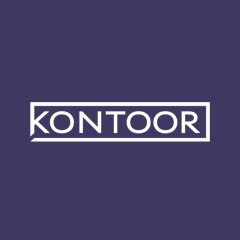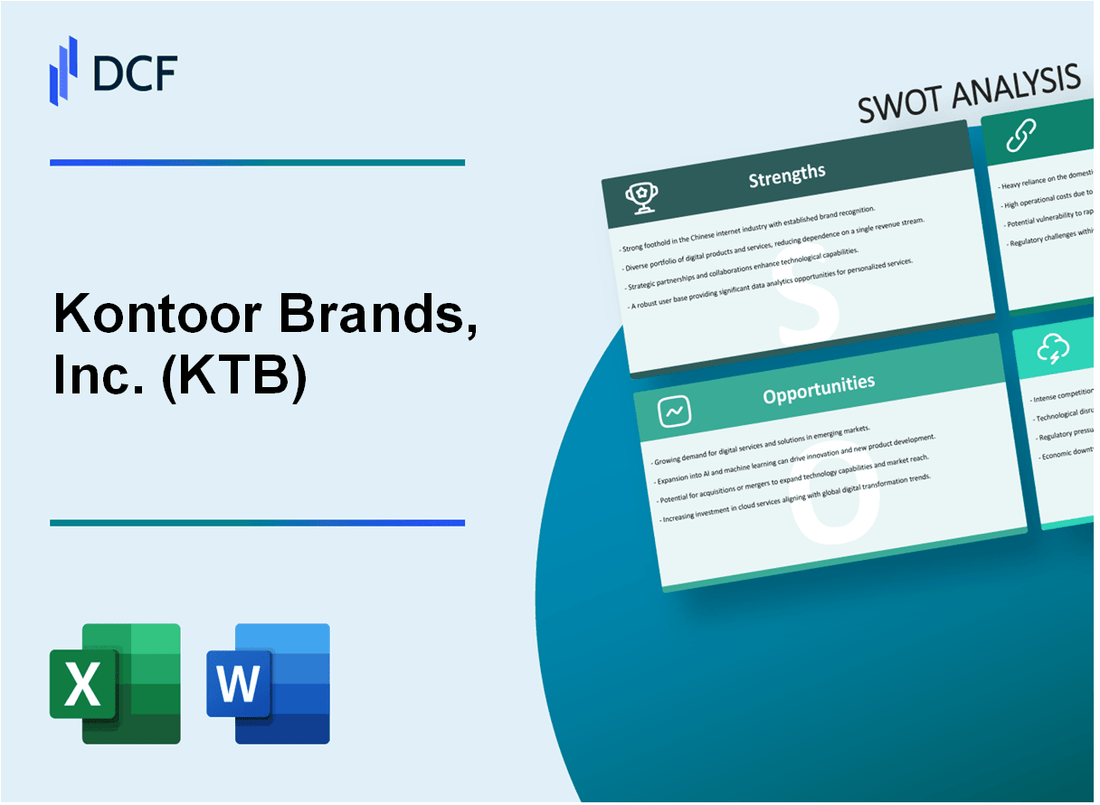
|
Kontoor Brands, Inc. (KTB): SWOT Analysis [Jan-2025 Updated] |

Fully Editable: Tailor To Your Needs In Excel Or Sheets
Professional Design: Trusted, Industry-Standard Templates
Investor-Approved Valuation Models
MAC/PC Compatible, Fully Unlocked
No Expertise Is Needed; Easy To Follow
Kontoor Brands, Inc. (KTB) Bundle
In the dynamic world of denim and apparel, Kontoor Brands, Inc. (KTB) stands at a critical juncture, navigating a complex landscape of global fashion markets, changing consumer preferences, and intense competition. This comprehensive SWOT analysis reveals the strategic positioning of a company that owns legendary brands Wrangler and Lee, offering an insightful look into its potential for growth, challenges, and strategic opportunities in the ever-evolving fashion industry. From its robust global distribution network to the emerging trends in sustainable fashion, Kontoor Brands is poised to leverage its strengths while addressing critical market challenges.
Kontoor Brands, Inc. (KTB) - SWOT Analysis: Strengths
Iconic Denim Brands: Wrangler and Lee
Kontoor Brands owns two globally recognized denim brands with significant market presence:
| Brand | Global Market Share | Annual Revenue (2022) |
|---|---|---|
| Wrangler | 15.4% | $1.2 billion |
| Lee | 8.7% | $685 million |
Global Distribution Network
Kontoor Brands operates across multiple retail channels:
- Presence in 50+ countries
- Over 7,000 retail points of sale
- E-commerce platforms in 20 markets
Diversified Product Portfolio
| Product Category | Percentage of Revenue |
|---|---|
| Jeans | 68% |
| Jackets | 12% |
| Other Apparel | 20% |
Manufacturing Infrastructure
Manufacturing Capabilities:
- 6 owned manufacturing facilities
- 22 contracted manufacturing locations
- Annual production capacity: 75 million units
Brand Loyalty and Heritage
Market performance metrics:
| Metric | Value |
|---|---|
| Customer Retention Rate | 62% |
| Brand Loyalty Score | 8.3/10 |
| Average Customer Lifetime Value | $1,450 |
Kontoor Brands, Inc. (KTB) - SWOT Analysis: Weaknesses
Highly Dependent on Denim and Casual Apparel Market
As of 2023, Kontoor Brands generates approximately 87% of its revenue from denim and casual apparel segments. The company's primary brands, Wrangler and Lee, are concentrated in this specific market niche.
| Revenue Source | Percentage |
|---|---|
| Denim Segment | 62% |
| Casual Apparel | 25% |
| Other Segments | 13% |
Vulnerable to Fluctuating Raw Material Costs
Cotton prices significantly impact Kontoor Brands' production costs. In 2023, cotton prices ranged between $0.80 and $1.20 per pound, creating substantial cost volatility.
- Cotton price fluctuation impact: 4-7% on overall production expenses
- Annual raw material procurement: Approximately $450 million
- Hedging strategies cover only 40-50% of potential price risks
Limited Digital and E-commerce Capabilities
Digital sales represent only 18% of total revenue in 2023, significantly lower than industry leaders like Levi Strauss at 36% digital revenue.
| Digital Sales Metric | Kontoor Brands | Industry Average |
|---|---|---|
| E-commerce Revenue Percentage | 18% | 28% |
| Online Traffic Conversion Rate | 2.4% | 3.7% |
Sensitive to Economic Downturns
Consumer discretionary spending directly impacts Kontoor Brands' performance. During economic contractions, the company experiences significant revenue challenges.
- Revenue decline during 2020 pandemic: 22%
- Average consumer spending reduction: 15-18% in discretionary clothing
Relatively Smaller Market Share
Kontoor Brands holds approximately 5.2% of the global denim market, compared to larger competitors.
| Competitor | Market Share |
|---|---|
| Levi Strauss | 14.5% |
| VF Corporation | 9.3% |
| Kontoor Brands | 5.2% |
Kontoor Brands, Inc. (KTB) - SWOT Analysis: Opportunities
Growing Trend towards Sustainable and Eco-Friendly Fashion
The global sustainable fashion market was valued at $6.35 billion in 2019 and is projected to reach $8.25 billion by 2023, with a CAGR of 6.8%.
| Sustainable Fashion Market Metrics | Value |
|---|---|
| Global Market Size (2019) | $6.35 billion |
| Projected Market Size (2023) | $8.25 billion |
| Compound Annual Growth Rate | 6.8% |
Expanding Direct-to-Consumer (DTC) and E-Commerce Sales Channels
E-commerce apparel sales reached $153.6 billion in 2020, representing 36% of total apparel sales in the United States.
- Online apparel sales growth rate: 15.2% annually
- Projected DTC channel revenue increase: 22% by 2025
Potential for International Market Expansion
| Emerging Market Potential | Market Size |
|---|---|
| India Apparel Market | $59.3 billion (2020) |
| China Apparel Market | $298 billion (2020) |
| Brazil Apparel Market | $43.7 billion (2020) |
Growing Demand for Versatile and Comfortable Workwear and Casual Clothing
Casual and comfortable clothing market expected to grow at 5.6% CAGR from 2021 to 2026.
- Remote work clothing segment: 34% market share increase
- Athleisure wear market value: $211 billion by 2025
Potential for Innovative Product Lines Targeting Younger Demographics
Generation Z and Millennial apparel spending projected to reach $143 billion by 2025.
| Demographic Spending Metrics | Value |
|---|---|
| Generation Z Apparel Spending | $75 billion |
| Millennial Apparel Spending | $68 billion |
| Total Projected Spending | $143 billion |
Kontoor Brands, Inc. (KTB) - SWOT Analysis: Threats
Intense Competition in the Denim and Casual Apparel Market
The global denim market was valued at $57.3 billion in 2022 and is projected to reach $79.1 billion by 2030, with a CAGR of 4.2%. Kontoor Brands faces competition from major players like Levi Strauss & Co., which reported $6.2 billion in revenue in 2022, and VF Corporation, with $12.3 billion in annual revenue.
| Competitor | 2022 Revenue | Market Share |
|---|---|---|
| Levi Strauss & Co. | $6.2 billion | 15.3% |
| VF Corporation | $12.3 billion | 22.7% |
| Kontoor Brands | $2.9 billion | 7.2% |
Rapidly Changing Consumer Preferences and Fashion Trends
The global apparel market experiences significant volatility, with 73% of consumers indicating they change fashion preferences at least twice a year. E-commerce apparel sales reached $185.4 billion in 2022, representing 32.5% of total apparel sales.
- Online fashion sales growth rate: 14.5% annually
- Sustainable fashion market expected to reach $8.25 billion by 2023
- Gen Z consumers prioritize sustainability and ethical production
Potential Supply Chain Disruptions from Global Economic Uncertainties
Global supply chain disruptions cost companies an estimated $228 billion in 2022. The textile and apparel industry experienced 37% increased logistics costs and 22% longer shipping times.
| Supply Chain Metric | 2022 Impact |
|---|---|
| Total Disruption Costs | $228 billion |
| Logistics Cost Increase | 37% |
| Shipping Time Extension | 22% |
Rising Production Costs and Potential Tariff Challenges
Cotton prices increased by 40% in 2022, reaching $1.12 per pound. Textile import tariffs range from 12% to 32%, directly impacting manufacturing costs.
- Raw material cost volatility: 25-45% fluctuation
- Average manufacturing labor costs increased by 8.3%
- Energy costs for textile production up 22% in 2022
Increasing Pressure from Fast-Fashion and Online-First Clothing Brands
Fast-fashion brands like SHEIN generated $30.3 billion in revenue in 2022, capturing significant market share from traditional apparel companies. Online-first brands grew 67% faster than traditional retail channels.
| Fast-Fashion Metric | 2022 Data |
|---|---|
| SHEIN Revenue | $30.3 billion |
| Online Clothing Sales Growth | 67% |
| Digital Market Penetration | 42.5% |
Disclaimer
All information, articles, and product details provided on this website are for general informational and educational purposes only. We do not claim any ownership over, nor do we intend to infringe upon, any trademarks, copyrights, logos, brand names, or other intellectual property mentioned or depicted on this site. Such intellectual property remains the property of its respective owners, and any references here are made solely for identification or informational purposes, without implying any affiliation, endorsement, or partnership.
We make no representations or warranties, express or implied, regarding the accuracy, completeness, or suitability of any content or products presented. Nothing on this website should be construed as legal, tax, investment, financial, medical, or other professional advice. In addition, no part of this site—including articles or product references—constitutes a solicitation, recommendation, endorsement, advertisement, or offer to buy or sell any securities, franchises, or other financial instruments, particularly in jurisdictions where such activity would be unlawful.
All content is of a general nature and may not address the specific circumstances of any individual or entity. It is not a substitute for professional advice or services. Any actions you take based on the information provided here are strictly at your own risk. You accept full responsibility for any decisions or outcomes arising from your use of this website and agree to release us from any liability in connection with your use of, or reliance upon, the content or products found herein.
